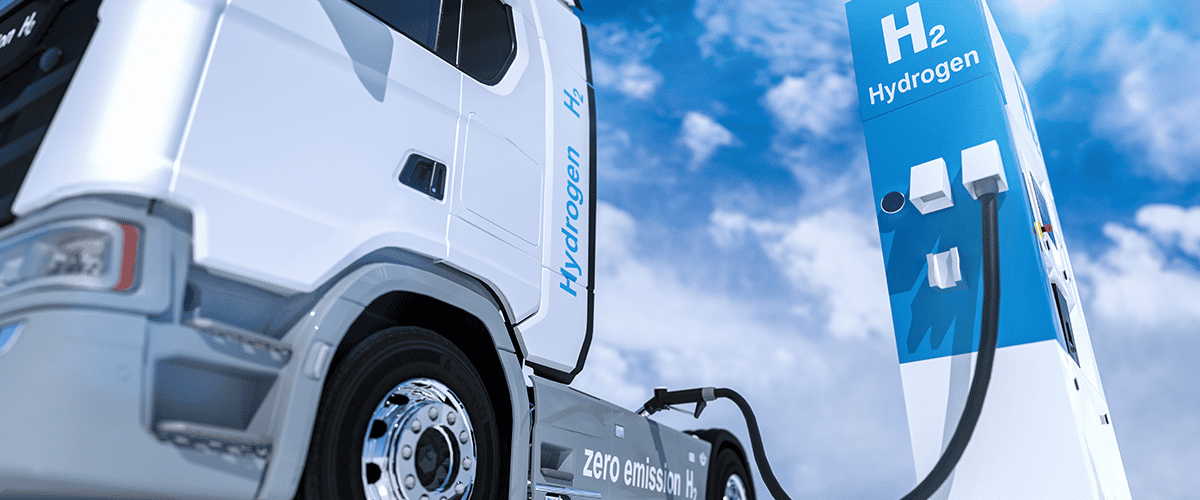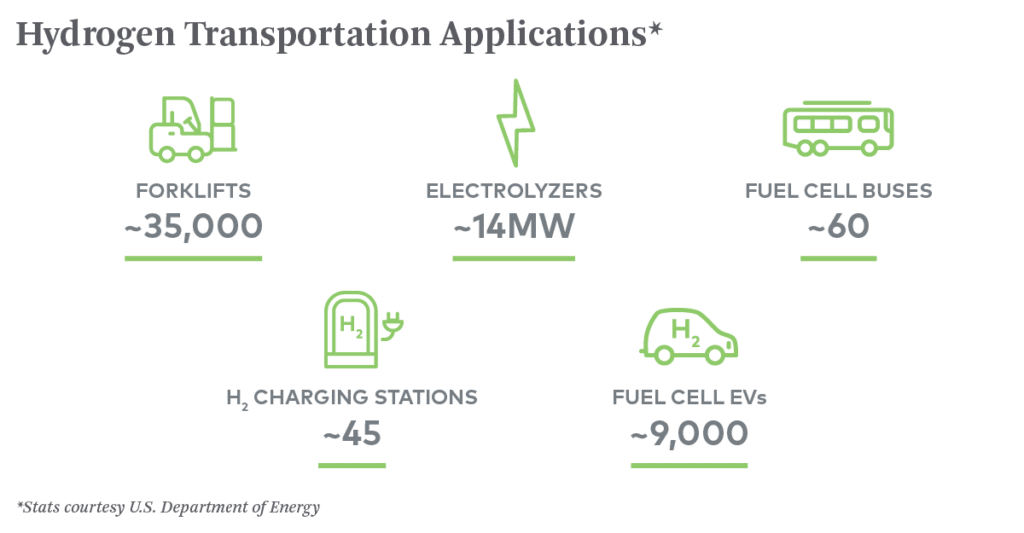Hydrogen has the potential to make significant contributions to transportation decarbonization, especially in heavy-duty vehicle applications. However, there is some disagreement on the best, most environmentally conscious ways to produce and use hydrogen as a fuel. As we discussed in part one of our blog series, the energy efficiency and climate impact of hydrogen fuel hinges on the feedstock and source of the electricity used in the production process. Hydrogen’s wide range in carbon intensity is attributable to the number of production pathways and processing technologies that exist. Pathways such as coal gasification, fossil methane SMR, and electrolysis–using a grid mix or renewables–each have their own range of GHG emissions because of unique feedstock extraction and hydrogen fuel conversion practices.
Regardless of source, hydrogen is a strong alternative fuel option as it can be used in fuel cell electric vehicles (FCEVs), which are electric vehicles that combine a hydrogen fuel cell and a motor. Electricity is generated by combining hydrogen with oxygen from the air. This power generation is performed inside the fuel cell and does not release any harmful emissions—just clean water and heat.
Fueling time and driving range are two distinguishing factors that set FCEVs apart from other electric vehicles. It takes about 5 minutes to fill a hydrogen tank, and when full, the tank’s range is similar to that of a standard internal combustion engine vehicle [1]. Because fuel cells are 2-3 times as efficient as internal combustion engines [2], one kilogram (kg) of hydrogen, which contains roughly the same amount of energy as a gallon of gasoline, can power a car for about 60 miles, while one gallon of gasoline sustains about 25 miles of travel. Fuel cells also make vehicles quieter and permit longer travel distance with fewer refueling requirements.
Opportunities and Challenges
Today, hydrogen is about $13/kg and is becoming more affordable with technological advancements and infrastructure expansion. To fully achieve hydrogen’s capacity to decarbonize, it will be important to scale up technologies in key sectors, encourage innovation in hydrogen pathways, continue research and development for cost reduction, and develop industry-wide hydrogen standards.
Hydrogen fuel cells aren’t confined to road vehicles; the use of hydrogen fuel cell forklifts for material handling applications is increasing in popularity. There are roughly 35,000 hydrogen fuel cell forklifts currently in use in warehouses, stores and manufacturing facilities throughout the United States, compared to an estimated 9,000 FCEVs on the road [3].
Efficiency gains are the main value proposition for forklifts—with hydrogen it takes just a couple of minutes to recharge a whole fleet, while an electric forklift takes up valuable space in facilities and warehouses while charging. By moving from battery or propane forklifts to fuel cell forklifts, a company can shrink their carbon footprint and maximize the profitability of each square foot of the warehouse. The shorter refueling time made available through fuel cells means reduced operational downtime and more optimized supply chains.
Clean hydrogen has the potential to significantly reduce emissions from transport, especially in heavy-duty applications that have proven hard to decarbonize, such as long-range or utility vehicles, forklifts, buses, trucks, trains, maritime and aviation. Clean hydrogen fuel can help to catalyze electric mobility in large fleets where battery-electric options are in short supply.
With hydrogen, we see the same chicken and egg issue as previously mentioned with national EV infrastructure. Hydrogen production requires a large, centralized operation and therefore production sites are sporadic across the western United States. Similarly, FCEV availability is limited to areas with an adequate number of hydrogen refueling stations.
Financial Incentives and Policy Support
California’s Low Carbon Fuel Standard (LCFS) is a major force for deploying zero emissions vehicle infrastructure, including hydrogen refueling infrastructure (HRI). The LCFS provides significant incentive value to lower the carbon intensity of hydrogen, and its infrastructure provision allows credits to be generated from deploying HRI capacity. HRI credits are issued according to a number of inputs, including capacity of a station, station availability or up time, as well as the carbon intensity of the hydrogen dispensed. These credits incentivize infrastructure roll out by ensuring hydrogen stations generate a minimum number of LCFS credits. As the station dispenses more hydrogen, the number of infrastructure credits it generates are reduced and credits from the fuel increase.
Program rules dictate how renewable electricity supply in the form of renewable energy certificates (RECs) can be used to reduce the carbon intensity of hydrogen production. To qualify, RECs must have been generated within three quarters of the hydrogen production, be located on the same grid, meet California’s RPS eligibility rules, and not be counted toward any other voluntary or compliance program. RECs are used across the country to track, transact, and consume renewable electricity on the shared grid while preventing double counting.
Oregon and Washington have similar programs to the LCFS that encourage renewable hydrogen deployment. However, Oregon has no hydrogen production facilities, so hydrogen is often sourced from California-based producers and transported to facilities in Oregon to power hydrogen fuel cell forklifts. Under the CFP, 3Degrees developed the very first hydrogen pathway to generate credits and has issued 100% of the hydrogen credits issued under the Oregon CFP to date.
In addition to the current incentives under the LCFS, the California Air Resources Board (CARB) recently proposed the extension of HRI provisions to support hydrogen refueling infrastructure for medium- and heavy-duty vehicles. While this proposal is not finalized and is not guaranteed to be adopted, it could spur significant uptake of these vehicles, as most observers agree the greatest opportunities for FCEVs are in heavy-duty vehicles. Major advancement opportunities for hydrogen fuels exist in the trucking, shipping and handling, and manufacturing industries. Hydrogen will be key to meeting climate goals, but the high cost of ownership and shortage of infrastructure are obstacles that delay full deployment. Through policy support, technological innovation, and financial investment, hydrogen can be utilized at scale.
How We Help
For organizations exploring ways to accelerate the shift to low-carbon transportation, participating in clean fuels programs offers a path to access lucrative incentives for lower carbon initiatives to reduce the total cost of ownership of zero emissions vehicles and help finance a full transition. Earning credits can help cover the cost of hydrogen projects, but configuring transactions to get value for them is not an easy task. Meeting qualifications for these programs can be challenging—the hydrogen itself must meet a certain level of renewable content to be eligible for each program and there is a whole range of record keeping and monitoring requirements.
Working with an advisor alleviates the administrative burden and can help businesses recognize the highest possible value for participating in these programs. 3Degrees can help your organization reduce its transportation emissions by enabling a cost-competitive transition to zero emissions vehicles. To learn more about our transportation offerings, please get in touch.
Resources:
- 5 Things To Know When Filling Up Your Fuel Cell Electric Vehicle. U.S. Department of Energy, 2016.
- Hydrogen’s Role in Transportation. U.S. Department of Energy, 2022.
- Hydrogen and Fuel Cell Technologies Office Overview. U.S. Department of Energy, 2021.



